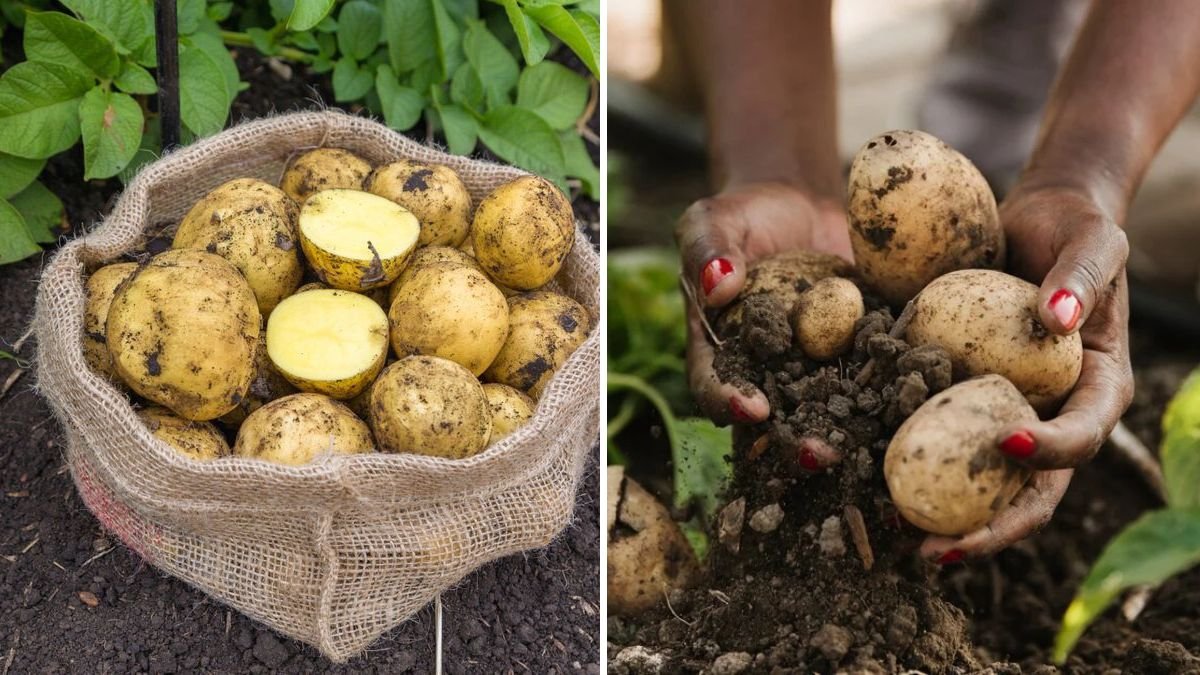Potatoes are one of the most versatile and widely grown vegetables in home gardens, but traditional in-ground cultivation can be labor-intensive, requiring digging and significant space. A potato bag system provides an innovative solution: it allows gardeners to grow potatoes in a compact, controlled environment with minimal effort while producing abundant yields.
This guide explores how to grow potatoes in a bag, covering materials, planting techniques, maintenance, and harvest strategies to make your potato cultivation both simple and productive.
1. Why Grow Potatoes in a Bag?
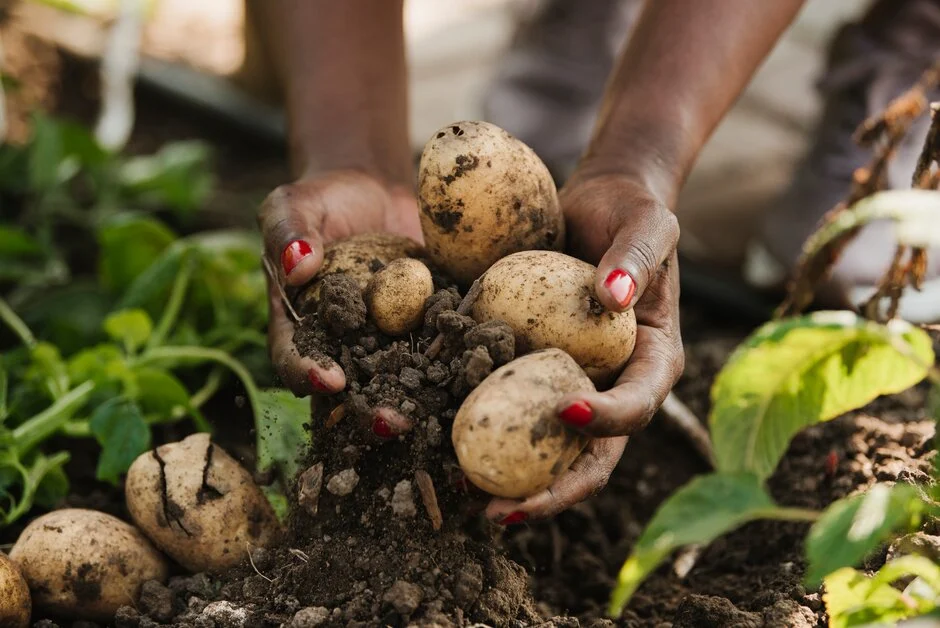
Growing potatoes in a bag offers several advantages over conventional methods:
a. Space Efficiency
- Ideal for small gardens, balconies, patios, or urban spaces.
- Uses vertical space rather than spreading horizontally.
b. Easy Harvesting
- No digging through soil required; simply tip the bag or pull back layers to access tubers.
- Reduces risk of damaging potatoes during harvest.
c. Better Drainage and Soil Control
- Bags allow excellent drainage, reducing rot and fungal issues.
- Growers can control soil composition for optimal potato growth.
d. Extended Growing Season
- Bags can be moved to maximize sunlight or protect from frost, allowing for longer harvest windows.
e. Pest and Weed Reduction
- Raised containers and bag systems limit exposure to pests like wireworms or slugs.
- Minimal soil exposure reduces weed competition.
This method is ideal for beginners, urban gardeners, or those with limited space.
2. Choosing the Right Potato Variety
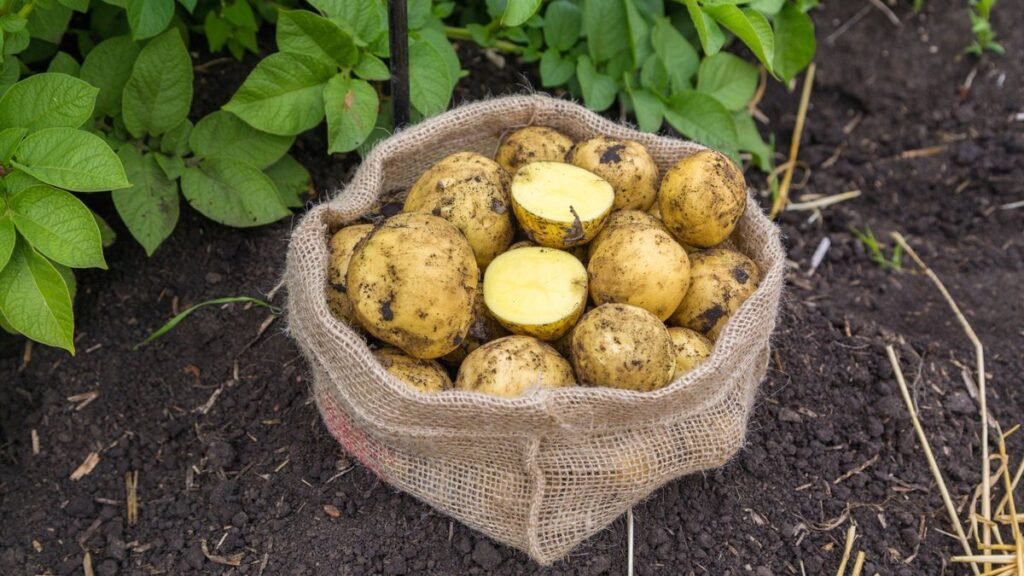
Selecting the right variety is crucial for success in a bag system:
- Early Varieties: Grow quickly (8–10 weeks), ideal for smaller bags. Examples: ‘Red Pontiac,’ ‘Yukon Gold,’ ‘Charlotte.’
- Mid-Season Varieties: Produce larger harvests, suitable for larger bags. Examples: ‘Kennebec,’ ‘Maris Piper.’
- Late Varieties: Produce bigger, long-storage potatoes; require more space and time. Examples: ‘Russet Burbank,’ ‘Katahdin.’
Consider your climate, bag size, and harvest goals when choosing potato types for bag cultivation.
3. Materials Needed for Potato Bag Gardening
To grow potatoes in a bag, gather the following materials:
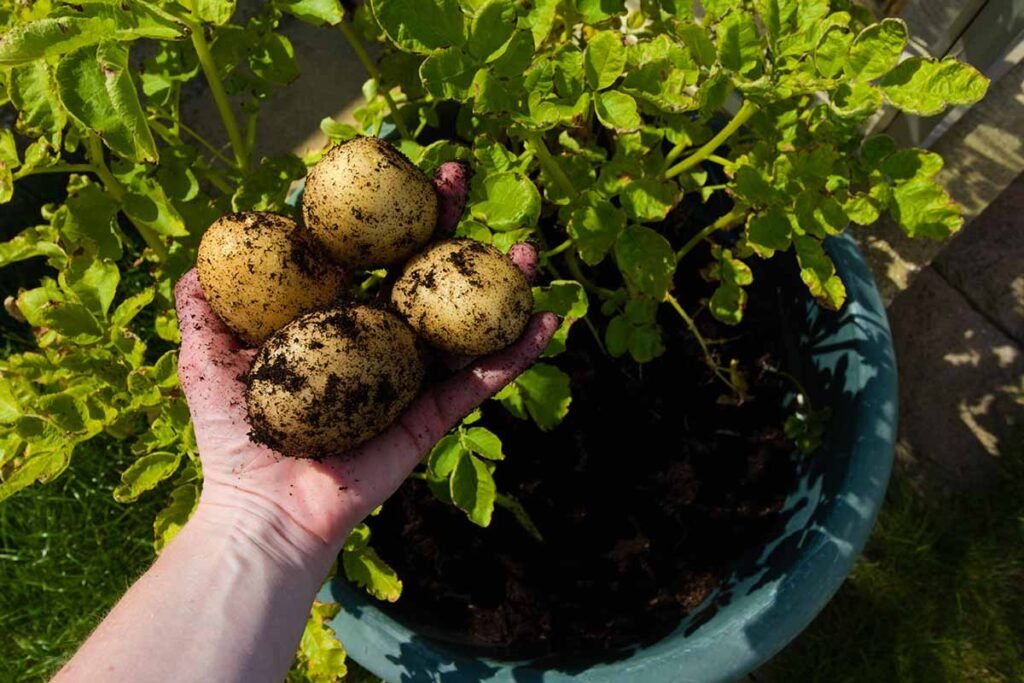
- Potato Bag or Large Container:
- A sturdy fabric grow bag, burlap sack, or large plastic container (15–20 gallons).
- Ensure good drainage at the bottom.
- Seed Potatoes:
- Certified disease-free potatoes with healthy “eyes.”
- Soil Mix:
- Well-draining, nutrient-rich potting mix.
- Mix with compost or aged manure for optimal growth.
- Optional Mulch:
- Straw or shredded leaves to cover soil and maintain moisture.
- Watering Can or Hose:
- Ensure consistent moisture without waterlogging the bag.
- Fertilizer:
- Balanced organic fertilizer or slow-release pellets to support tuber development.
With the right materials, potato bags can produce high yields with minimal effort.
4. Preparing the Potato Bag
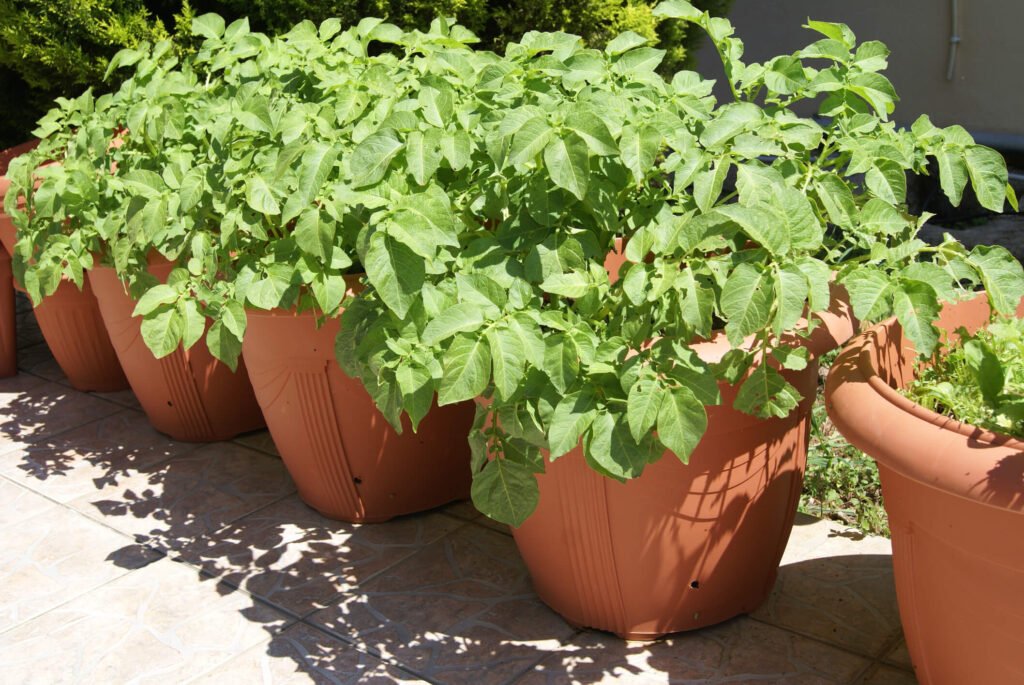
Proper preparation ensures optimal potato growth:
Step 1: Select and Prepare Seed Potatoes
- Choose small to medium-sized potatoes with 1–2 “eyes.”
- Cut larger potatoes into pieces, ensuring each piece has at least one eye.
- Allow cut pieces to cure or dry for 1–2 days to prevent rot.
Step 2: Prepare the Bag
- Place a layer of gravel or small stones at the bottom (optional) for extra drainage.
- Add 4–6 inches of soil or potting mix at the bottom of the bag.
Step 3: Plant Seed Potatoes
- Place seed potatoes on top of the soil, eyes facing up.
- Cover with 3–4 inches of soil or compost.
This setup allows tubers to grow upward and expand as soil is added.
5. Growing Techniques for Potato Bags
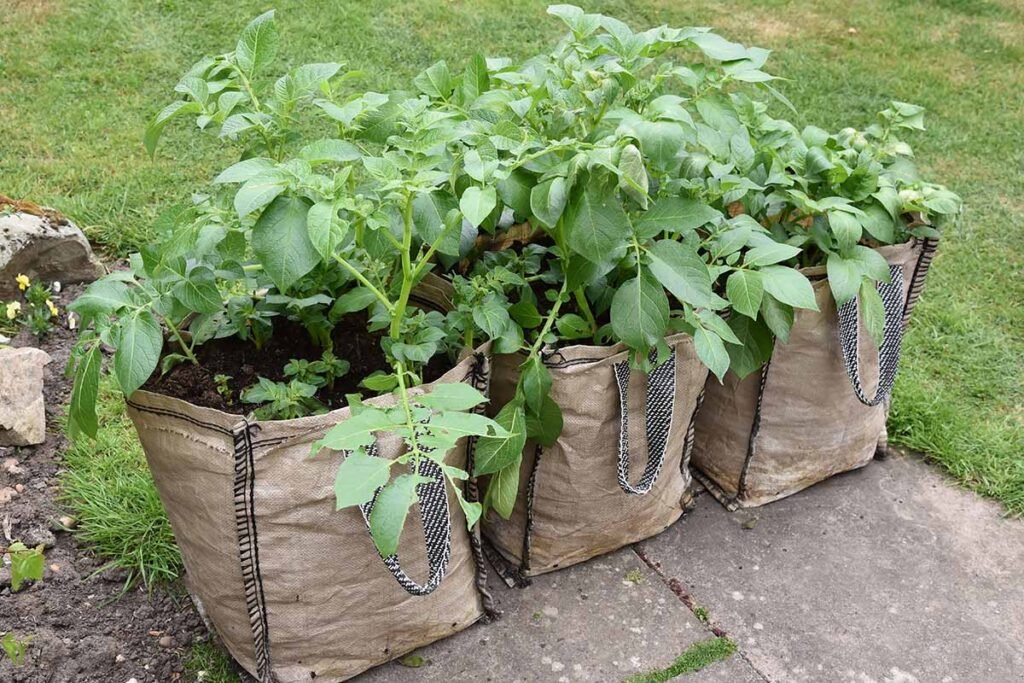
The key to maximizing potato yield in a bag is layering soil as plants grow:
a. Hilling
- As potato shoots reach 6–8 inches, add another 3–4 inches of soil or compost to cover stems.
- Repeat hilling every few weeks until the bag is nearly full.
- Hilling encourages the development of more tubers along buried stems.
b. Watering
- Keep soil consistently moist but not soggy.
- Water deeply, allowing water to reach the bottom of the bag.
- Fabric bags dry faster than ground soil, so monitor moisture regularly.
c. Fertilizing
- Use organic fertilizers or compost tea every 2–3 weeks.
- Avoid excessive nitrogen, which promotes foliage growth over tuber production.
d. Sunlight
- Place bags in a location with at least 6–8 hours of sunlight daily.
- Rotate bags if needed to ensure even light distribution.
Following these techniques ensures strong foliage and maximum tuber growth.
6. Pest and Disease Management in Potato Bags
Potato bags reduce soil-borne issues, but some pests and diseases can still occur:
a. Common Pests
- Aphids, Colorado potato beetles, and wireworms may affect potato plants.
- Use organic sprays, neem oil, or hand-picking to control infestations.
b. Disease Prevention
- Avoid overwatering to prevent late blight and rot.
- Use certified disease-free seed potatoes.
- Ensure good air circulation around bags to reduce fungal issues.
Proper vigilance ensures healthy plants and high-quality tubers.
7. Harvesting Potatoes From Bags
Harvesting potatoes in a bag is simple and convenient:
Step 1: Monitor Plant Maturity
- Early varieties: 8–12 weeks after planting.
- Mid-season varieties: 12–16 weeks.
- Late varieties: 16–20 weeks or until foliage begins to yellow and die back.
Step 2: Harvest Tubers
- Tip the bag over or pull back layers of soil to access potatoes.
- Collect tubers gently to avoid bruising or cutting.
- Leave smaller tubers in the bag to continue growing if the plant is still alive.
Step 3: Curing and Storage
- Let harvested potatoes air dry for 1–2 days in a cool, shaded area.
- Store in a dark, cool, and dry place to prevent sprouting and rot.
Bag-grown potatoes are easier to harvest and produce clean, undamaged tubers.
8. Advantages Over Traditional Potato Planting
Growing potatoes in bags offers several advantages:
- Labor-Saving: No digging trenches or hilling mounds in the ground.
- Space-Saving: Grow potatoes in small spaces or vertical arrangements.
- Ease of Harvest: Simply tip the bag and collect tubers.
- Cleaner Produce: Tubers grow contained, reducing soil contamination.
- Mobility: Move bags to protect plants from frost, excessive rain, or pests.
These benefits make bag-grown potatoes ideal for urban and small-space gardeners.
9. Tips for Maximizing Potato Bag Yield
- Choose Large Bags: 15–20 gallon bags provide ample room for tuber growth.
- Plant Multiple Bags: Stagger planting times for continuous harvests.
- Mix Soil with Compost: Rich, loose soil encourages more tubers.
- Keep Foliage Healthy: Healthy leaves ensure energy for tuber production.
- Monitor Moisture Closely: Bag soil dries faster than garden soil, so water consistently.
Following these tips ensures a bountiful harvest from each potato bag.
10. Conclusion: Simplify Potato Gardening With Bags
Growing potatoes in a bag is an innovative, space-efficient, and low-maintenance method for both novice and experienced gardeners. By providing controlled soil, excellent drainage, and easy access to tubers, potato bags simplify planting, care, and harvesting.
From selecting the right variety and preparing seed potatoes to proper hilling, watering, and harvesting, potato bag gardening is a practical and rewarding solution for producing high yields in limited space. Whether you have a balcony, patio, or small backyard, growing potatoes in a bag transforms potato gardening into an easy, productive, and enjoyable experience.
By adopting this method, gardeners can enjoy fresh, homegrown potatoes with minimal labor, efficient water use, and maximum convenience—all while cultivating a more sustainable and flexible garden.
